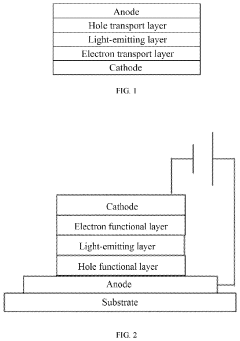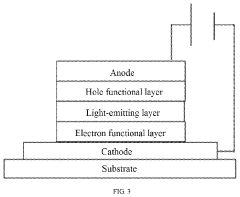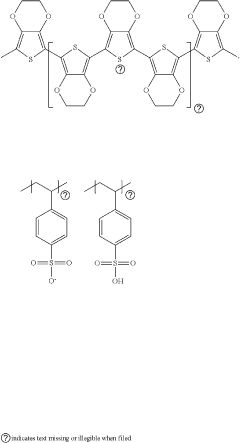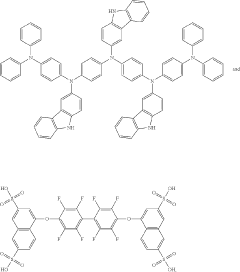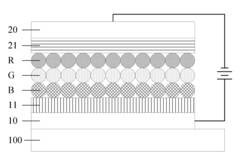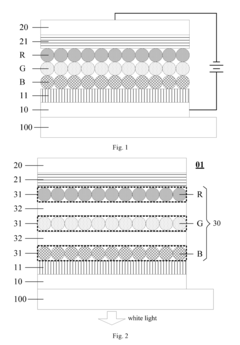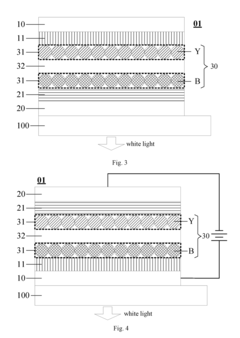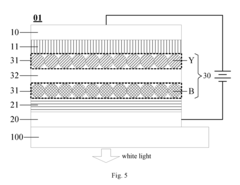QLED Technology: Breaking New Ground in Display Innovations
QLED Evolution and Objectives
Quantum Dot Light Emitting Diode (QLED) technology has emerged as a groundbreaking innovation in the display industry, revolutionizing the way we perceive and interact with visual content. The evolution of QLED technology can be traced back to the early 2000s when researchers first began exploring the potential of quantum dots in display applications. Since then, QLED has undergone significant advancements, driven by the pursuit of superior image quality, energy efficiency, and cost-effectiveness.
The primary objective of QLED technology is to overcome the limitations of traditional LED and OLED displays while offering enhanced color accuracy, brightness, and longevity. By leveraging the unique properties of quantum dots, QLED aims to deliver a wider color gamut, improved contrast ratios, and higher peak brightness levels compared to conventional display technologies. This pursuit of excellence has led to continuous refinements in quantum dot synthesis, deposition techniques, and overall display architecture.
One of the key milestones in QLED evolution was the development of cadmium-free quantum dots, addressing environmental concerns and regulatory requirements. This breakthrough opened up new possibilities for widespread adoption of QLED technology across various consumer electronics and professional display markets. Subsequently, researchers and manufacturers have focused on optimizing quantum dot efficiency, stability, and integration with existing display manufacturing processes.
The ongoing evolution of QLED technology is driven by several ambitious objectives. These include achieving perfect color reproduction across the entire visible spectrum, extending the lifespan of QLED displays to match or surpass that of traditional LCD panels, and reducing power consumption to enhance energy efficiency. Additionally, there is a strong emphasis on developing flexible and transparent QLED displays, which could revolutionize the form factor of future devices and enable novel applications in augmented reality and smart surfaces.
Another critical objective in QLED evolution is the pursuit of cost-effective manufacturing techniques. As the technology matures, there is a concerted effort to streamline production processes, reduce material costs, and improve yield rates. This focus on economic viability is essential for QLED to compete effectively with established display technologies and gain widespread market adoption across various price segments.
Looking ahead, the future trajectory of QLED technology is poised to explore new frontiers in display innovation. Researchers are investigating the potential of perovskite quantum dots, which offer promising characteristics for next-generation displays. Furthermore, the integration of QLED with other emerging technologies, such as micro-LED and advanced backlight systems, is expected to push the boundaries of display performance and versatility.
Market Demand for QLED Displays
The market demand for QLED displays has been experiencing significant growth, driven by the increasing consumer appetite for high-quality visual experiences across various applications. QLED technology, with its superior color reproduction, brightness, and energy efficiency, has positioned itself as a formidable competitor in the premium display market.
In the consumer electronics sector, QLED displays have gained substantial traction, particularly in the television segment. The technology's ability to deliver vibrant colors, deep blacks, and high contrast ratios has resonated with consumers seeking immersive viewing experiences. This demand has been further amplified by the rising popularity of 4K and 8K content, where QLED's color accuracy and brightness capabilities shine.
The gaming industry has also emerged as a key driver for QLED display demand. Gamers value the technology's low input lag, high refresh rates, and excellent color performance, which contribute to a more responsive and visually stunning gaming experience. As the gaming market continues to expand, particularly in the high-end segment, the demand for QLED displays in gaming monitors and televisions is expected to grow correspondingly.
In the commercial sector, QLED technology has found applications in digital signage, control rooms, and high-end presentation displays. The technology's ability to maintain image quality even in brightly lit environments makes it particularly suitable for these applications. Industries such as retail, hospitality, and transportation have shown increasing interest in QLED displays for their advertising and information dissemination needs.
The automotive industry represents another emerging market for QLED technology. As vehicles become more technologically advanced, there is a growing demand for high-quality in-vehicle displays. QLED's wide color gamut and high brightness make it an attractive option for automotive infotainment systems and digital dashboards, especially in premium vehicle segments.
Market analysts project robust growth for the QLED display market in the coming years. Factors such as declining production costs, technological advancements, and increasing consumer awareness are expected to drive adoption across various sectors. However, the market also faces challenges, including competition from other display technologies like OLED and MicroLED, as well as potential supply chain disruptions affecting key components.
As QLED technology continues to evolve, addressing aspects such as viewing angle limitations and further improving energy efficiency, its market demand is likely to expand into new applications and industries. The ongoing research and development in quantum dot materials and manufacturing processes are expected to enhance the technology's capabilities, potentially opening up new market opportunities and solidifying its position in the display industry.
QLED Technical Challenges
QLED technology, while promising, faces several significant technical challenges that researchers and manufacturers must overcome to fully realize its potential. One of the primary hurdles is the stability and longevity of quantum dots. These nanocrystals are prone to degradation when exposed to air, moisture, and high temperatures, which can lead to a decrease in display performance over time. Developing more robust encapsulation methods and improving the inherent stability of quantum dots is crucial for ensuring the long-term reliability of QLED displays.
Another major challenge lies in the blue quantum dot efficiency. While red and green quantum dots have achieved high efficiency levels, blue quantum dots lag behind in terms of both efficiency and stability. This discrepancy affects the overall color balance and energy consumption of QLED displays. Researchers are actively working on improving blue quantum dot performance through various approaches, including exploring new materials and fine-tuning the quantum dot structure.
The manufacturing process for QLED displays also presents significant challenges. Achieving uniform deposition of quantum dots across large areas while maintaining precise control over their size and distribution is technically demanding. Current methods often result in inconsistencies that can affect display quality. Additionally, scaling up production to meet commercial demands while maintaining cost-effectiveness remains a hurdle for widespread adoption of QLED technology.
Color purity and gamut are areas where QLED technology excels, but there is still room for improvement. Enhancing the spectral purity of quantum dots to produce even more saturated colors without compromising efficiency is an ongoing challenge. This involves refining the synthesis process and exploring new quantum dot compositions that can offer narrower emission spectra.
Power efficiency is another critical area of focus. While QLEDs have made significant strides in energy efficiency, further improvements are necessary to compete with other display technologies, especially in mobile and portable devices where battery life is crucial. This challenge involves not only enhancing the quantum yield of the dots but also optimizing the overall display architecture to minimize energy losses.
Lastly, the environmental impact and toxicity of quantum dots pose challenges for widespread adoption. Many quantum dots contain heavy metals like cadmium, which raises concerns about their environmental friendliness and potential health risks. Developing "green" quantum dots that maintain high performance while using non-toxic materials is a significant focus of current research efforts in the field.
Current QLED Solutions
01 Quantum dot light-emitting diode structure
QLED displays utilize a structure incorporating quantum dots as the light-emitting material. This structure typically includes layers for electron transport, hole transport, and the quantum dot emissive layer. The quantum dots are precisely engineered nanocrystals that emit light of specific colors when excited, allowing for improved color accuracy and brightness in displays.- Quantum dot light-emitting diode structure: QLED displays utilize a structure incorporating quantum dots as the light-emitting material. This structure typically includes layers for electron transport, hole transport, and the quantum dot emissive layer. The quantum dots are precisely engineered nanocrystals that emit light of specific wavelengths when excited, allowing for highly efficient and color-accurate displays.
- Color conversion and enhancement: QLED technology employs quantum dots for color conversion and enhancement. By using different sizes of quantum dots, the display can produce a wide color gamut with high color purity. This approach allows for more vivid and accurate color reproduction compared to traditional LED displays, improving overall picture quality and viewer experience.
- Quantum dot synthesis and application methods: Advanced methods for synthesizing and applying quantum dots are crucial for QLED display manufacturing. These techniques focus on creating uniform, stable quantum dots and effectively incorporating them into the display structure. Innovations in this area include improved quantum dot materials, deposition techniques, and encapsulation methods to enhance display performance and longevity.
- Backlight and optical designs: QLED displays often utilize innovative backlight and optical designs to maximize the benefits of quantum dot technology. These designs may include specialized light guide plates, reflective structures, and optical films that enhance light extraction efficiency and uniformity. Such optimizations contribute to improved brightness, contrast, and energy efficiency in QLED displays.
- Integration with other display technologies: QLED technology can be integrated with other display technologies to create hybrid solutions. This includes combining quantum dots with OLED or micro-LED technologies, or incorporating them into flexible or transparent display designs. These integrations aim to leverage the strengths of multiple technologies, potentially leading to displays with superior performance characteristics across various metrics.
02 Color conversion and enhancement techniques
QLED technology employs various color conversion and enhancement techniques to improve display performance. These may include using quantum dots to convert blue light to other colors, optimizing quantum dot compositions for specific color outputs, and implementing color filters to refine the spectral output. Such techniques contribute to wider color gamuts and more vibrant displays.Expand Specific Solutions03 Quantum dot synthesis and deposition methods
Advanced methods for synthesizing and depositing quantum dots are crucial for QLED display manufacturing. These processes involve precise control of quantum dot size, composition, and uniformity. Deposition techniques may include inkjet printing, photolithography, or transfer printing to achieve accurate placement of quantum dots in the display structure.Expand Specific Solutions04 Backlight and optical stack optimization
QLED displays often incorporate optimized backlight systems and optical stacks to enhance overall performance. This may include specialized light guide plates, diffusers, and reflectors to improve light distribution and efficiency. Additionally, advanced optical films and quantum dot enhancement films may be used to further boost color and contrast.Expand Specific Solutions05 Driving and control systems for QLED displays
Sophisticated driving and control systems are developed to manage QLED displays effectively. These systems may include advanced timing controllers, voltage regulation circuits, and thermal management solutions. They are designed to optimize power efficiency, maintain color accuracy over time, and ensure consistent performance across the display panel.Expand Specific Solutions
QLED Industry Leaders
QLED technology is currently in a growth phase, with the market expanding rapidly due to increasing demand for high-quality displays. The global QLED market size is projected to reach significant figures in the coming years, driven by applications in televisions, smartphones, and other electronic devices. Technologically, QLED is maturing but still evolving, with companies like BOE Technology Group, TCL China Star Optoelectronics, and Sharp Corp. leading innovations. These firms, along with others like Shenzhen China Star Optoelectronics and Hefei Visionox Technology, are investing heavily in R&D to enhance QLED performance, efficiency, and cost-effectiveness. The competitive landscape is intense, with both established players and emerging companies vying for market share through technological advancements and strategic partnerships.
BOE Technology Group Co., Ltd.
TCL China Star Optoelectronics Technology Co., Ltd.
Key QLED Innovations
- An optoelectronic device with a quantum dot light-emitting layer in a core-shell structure, where the valence band top energy level difference between the shell layer material and the hole transport material is greater than or equal to 0.5 eV, and the electron transport layer comprises zinc oxide nanomaterials bound with amine/carboxyl ligands of 3-8 carbon atoms, optimizing hole and electron injection balance and reducing charge accumulation.
- Incorporating a transparent insulating layer between neighboring QD light-emitting layers of different colors in a light-emitting device, which blocks high-energy exciton transfer and acts as a buffer to maintain light balance and prevent electric leakage.
Environmental Impact of QLED
The environmental impact of QLED (Quantum Dot Light Emitting Diode) technology is a crucial consideration as this innovative display technology continues to gain prominence in the consumer electronics market. QLED displays offer significant advantages in terms of energy efficiency compared to traditional LCD and OLED technologies, potentially reducing overall power consumption in devices.
One of the key environmental benefits of QLED technology lies in its longevity. QLED displays typically have a longer lifespan than their OLED counterparts, which can lead to reduced electronic waste over time. This durability factor contributes to a more sustainable product lifecycle, as consumers may need to replace their devices less frequently.
However, the production of quantum dots, the core component of QLED technology, raises some environmental concerns. The synthesis of quantum dots often involves the use of heavy metals and toxic chemicals, which require careful handling and disposal. Manufacturers are actively researching and developing more environmentally friendly production methods to mitigate these issues.
QLED displays also offer improved recycling potential compared to some other display technologies. The materials used in QLED panels, particularly the quantum dots, can potentially be recovered and reused in the production of new displays, contributing to a more circular economy in the electronics industry.
Energy consumption during the use phase of QLED displays is another area of environmental impact. While QLEDs are generally more energy-efficient than traditional LCDs, their power consumption can vary depending on the content being displayed and the brightness settings. Manufacturers are continually working on optimizing the energy efficiency of QLED displays to further reduce their environmental footprint.
The manufacturing process of QLED displays also has environmental implications. The production of these advanced displays requires sophisticated clean room facilities and energy-intensive processes. However, as the technology matures and production scales up, there is potential for improved manufacturing efficiency and reduced environmental impact per unit produced.
In terms of end-of-life considerations, the disposal and recycling of QLED displays present both challenges and opportunities. While the quantum dot materials can potentially be recovered, the complex nature of modern display panels requires specialized recycling processes to effectively separate and reclaim valuable materials.
QLED vs. OLED Comparison
QLED and OLED technologies represent two of the most advanced display innovations in the current market. While both offer superior picture quality compared to traditional LED-LCD displays, they achieve this through fundamentally different approaches.
QLED, or Quantum Dot Light Emitting Diode, is an evolution of LED technology. It uses a layer of quantum dots to enhance color and brightness. These nano-scale semiconductors emit light when excited by electricity, producing vibrant and accurate colors. QLED displays typically offer higher peak brightness levels, making them ideal for well-lit environments.
OLED, or Organic Light Emitting Diode, uses organic compounds that emit light when an electric current is applied. Each pixel in an OLED display is self-illuminating, allowing for perfect blacks and infinite contrast ratios. This technology excels in dark room viewing conditions and offers wider viewing angles compared to QLED.
In terms of color performance, both technologies can produce a wide color gamut. However, QLEDs often have an edge in color volume, maintaining vibrant colors even at high brightness levels. OLEDs, while capable of deep and rich colors, may struggle to maintain color accuracy at peak brightness.
Longevity is another point of comparison. QLED displays generally have longer lifespans and are less susceptible to burn-in, a phenomenon where static images can leave permanent marks on the screen. OLEDs, while improved in recent years, still face challenges with potential burn-in, especially in displays used for static content like news tickers or gaming HUDs.
Energy efficiency is an area where OLED typically outperforms QLED. Since OLED pixels emit their own light and can be turned off completely for black areas, they consume less power overall, especially when displaying darker content. QLEDs, relying on a backlight, tend to use more energy, particularly when displaying bright scenes.
In terms of cost, QLED technology generally offers a more affordable option, especially in larger screen sizes. The manufacturing process for QLED displays is less complex than that of OLED, allowing for more cost-effective production at scale. However, as OLED manufacturing techniques improve, this gap is narrowing.
Both technologies continue to evolve, with manufacturers pushing the boundaries of what's possible in display technology. The choice between QLED and OLED often comes down to specific use cases and viewing environments, with each offering distinct advantages in different scenarios.
